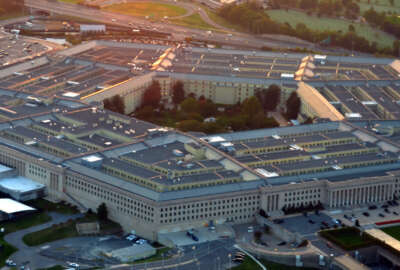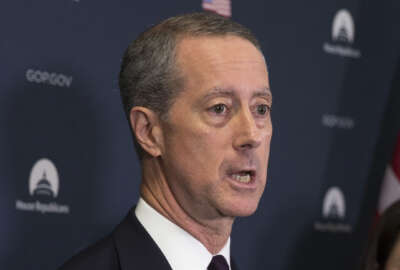
$700 billion Senate NDAA has fewer troops than House, focuses on cyber war
The Senate defense authorization bill increases the Army's active duty end strength by 5,000. It also creates a policy for responding to cyber attacks.
The Senate Armed Services Committee is empowering a new position in the Pentagon, stressing cyber warfare and taking a more conservative approach to force growth in its 2018 defense authorization bill.
The committee released details on its bill after spending the week behind closed doors marking up the legislation.
The bill authorizes a total of $700 billion for the Defense Department and related agencies. About $640 billion of that is in base budget spending, the other $62 billion is authorized for overseas contingency operations, a wartime account for operations overseas.
Like the House Armed Services Committee bill, the Senate version focuses on rebuilding the military’s readiness by paying for items on the military services’ wish lists.
The bill only authorizes a 2.1 percent increase in pay for members of the military, in contrast to the 2.4 percent increase mandated by the House version of the bill.
The bill does not provide an authorization for the base realignment and closure requested by the president’s budget.
Senate Armed Services Committee aides said the full text of the bill will be released after the July 4 week recess.
Third in command
The Senate bill further empowers the DoD’s chief management officer, a position that was created by last year’s defense authorization act.
Last year’s bill gave the CMO independent authority to order the services to implement reforms on matters like business planning, performance management and information technology.
This year’s bill solidifies the CMO as the third in command under the defense secretary and his deputy.
“What the markup seeks to do is clarify and enhance authority to some extent. What’s envisioned is an individual who is essentially running the defense-wide business operations,” a committee aide said. “There is an expectation that this individual would have line management responsibility over the defense agencies.”
The 2018 bill gives the CMO explicit authority over department wide shared services. It also expands the authority of the CMO to include oversight, direction and control of business-focused defense agencies and field activities.
The CMO will also assume some of the traditional chief information officer functions related to business IT systems.
The Senate version of the bill makes other bureaucratic changes too.
It requires DoD to reduce the number of deputy assistant secretaries of defense by 20 percent.
The bill continues to slash the number of Senior Executive Service personnel in the Pentagon by 10 percent. Last year the committee cut 25 percent from the staff.
The committee also wants to remove one assistant secretary from each military department.
Cyber policy
The committee checks off something from its chairman Sen. John McCain’s (R-Ariz.) wish list. McCain spent the past two years pressuring DoD for a cyber policy.
It seems McCain was fed up with waiting and created his own policy to deal with cyber attacks. The bill establishes a policy that the United States should employ all instruments of national power, including offensive cyber weapons, to deter and respond to cyber attacks with the intent to cause casualties, threaten infrastructure or disrupt normal business.
“The impetus for this is it’s not really clear what the national cyber policy is,” an aide said. “The authority remains in the hands of the president setting policy and setting strategy. I think this was an attempt by the committee to speak to where we would hope these questions of policy would be determined in terms of use, capability, development, what constitutes an act of war, what constitutes grounds for going further than we have in the past, how we think about threats that are coming through third parties.”
McCain was critical of previous cyber polices set by the executive branch. He called the Obama administration’s policy “wholly-lacking any new information about the administration’s plan to integrate ends, ways and means to meaningfully deter attacks in cyber space. It mostly reiterates steps taken and pronouncements made over the past few years, all of which we know have failed to deter our adversaries or decrease the vulnerability of our nation in cyber space.”
The Senate bill tries to better organize cyber within the Pentagon as well. It creates a chief information warfare officer, who is presidentially appointed and Senate-confirmed, to lead DoD in cyber operations, intelligence and space issues.
“There are things that the chief information officer does that are not dissimilar to the things CIOs in other federal agencies do. Then there is this information warfighting function that pertains to space control, cyber, electronic warfare and information assurance, spectrum management. Things that are very uniquely DoD information warfare functions and I think the thinking became these are probably more than one job,” a Senate Armed Services Committee aide said.
The CMO reform helped drive the split within the CIO office, the aide said.
The Senate bill does not create a Space Corps, like the House bill. The Space Corps would create an entirely new branch of the military based on space.
A Senate aide said the committee went beyond just looking at space in creating the chief information warfare office.
“It’s really a recognition that cyberspace, space and information have all coalesced and come to an area where they are all dominating the regime as a whole, but aren’t getting the level of focus that is required from each of the individual services,” the aide said.
Force strength
Despite authorizing slightly more money than the House version of the bill, the Senate bill does not ramp up force strength like the House.
The Senate increases the Army active duty strength by 5,000 and adds another 1,000 to the guard and reserve.
It also adds 1,000 more Marines than what the president requested in his budget.
The other services get the increase the president requested: 4,100 active in the Air Force and 4,000 in the Navy.
The House bill adds 10,000 Army active duty and 7,000 guard and reserve. It marks the rest of the services to the president’s request.
A Senate aide said the committee felt that adding 17,000 to the Army was more than could be done in one year.
“The belief was 6,000 is a responsible rate to grow in one year and address shortfalls that they have. Pushing far beyond that, at least in this committee’s view, was not a place we wanted to go. That’s not to suggest that the committee doesn’t think the Army shouldn’t grow beyond what they authorized it at, they just want to do it in future years,” the aide said.
Copyright © 2025 Federal News Network. All rights reserved. This website is not intended for users located within the European Economic Area.
Scott Maucione is a defense reporter for Federal News Network and reports on human capital, workforce and the Defense Department at-large.
Follow @smaucioneWFED





